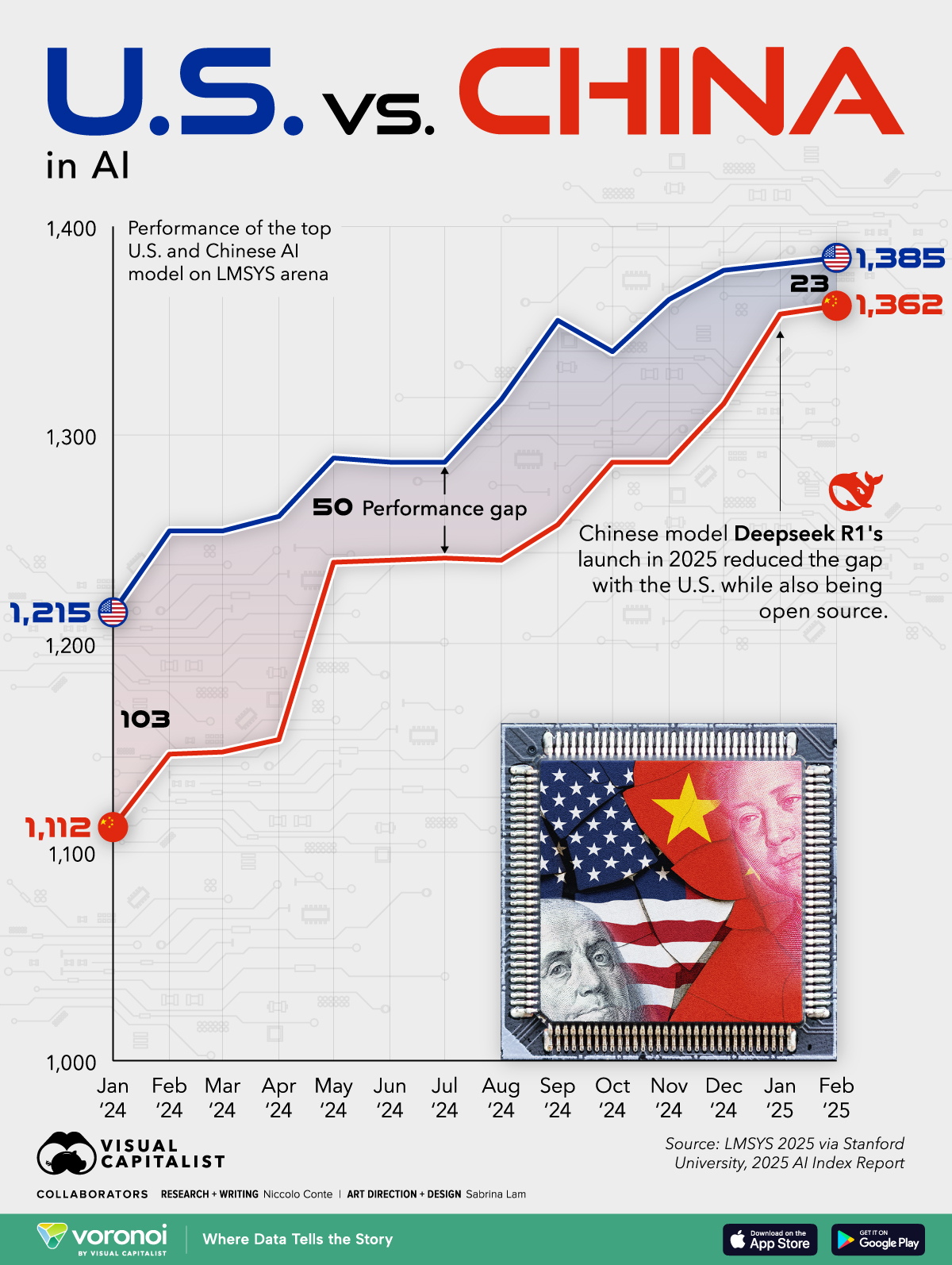![]()
See this visualization first on the Voronoi app.

China vs. U.S. AI Model Performance
This was originally posted on our Voronoi app. Download the app for free on iOS or Android and discover incredible data-driven charts from a variety of trusted sources.
The global AI race is heating up, evolving into a high-stakes battle spanning everything from semiconductors to talent acquisition.
One of the most important indicators of a country’s AI strength is the performance of their leading models. This graphic visualizes the performance of the top U.S. and Chinese AI models on LMSYS’s Chatbot Arena from January 2024 to February 2025.
Chatbot Arena is an open platform for benchmarking large language models based on crowd-sourced user preferences.
Data comes from LYMSYS via Stanford University’s 2025 AI Index Report.
This visualization is part of Visual Capitalist’s AI Week, sponsored by Terzo.
China is Narrowing the AI Performance Gap
Below, we show the performance of the top U.S. and Chinese AI models based on LMSYS’s Chatbot Arena from January 2024 to February 2025.
| Date | China model score | U.S. model score | Performance gap |
|---|---|---|---|
| 2024-01 | 1112 | 1215 | 103 |
| 2024-02 | 1147 | 1254 | 107 |
| 2024-03 | 1148 | 1254 | 105 |
| 2024-04 | 1154 | 1261 | 107 |
| 2024-05 | 1239 | 1289 | 50 |
| 2024-06 | 1240 | 1287 | 47 |
| 2024-07 | 1241 | 1287 | 47 |
| 2024-08 | 1240 | 1317 | 77 |
| 2024-09 | 1257 | 1355 | 98 |
| 2024-10 | 1287 | 1340 | 54 |
| 2024-11 | 1287 | 1365 | 78 |
| 2024-12 | 1315 | 1379 | 64 |
| 2025-01 | 1358 | 1382 | 24 |
| 2025-02 | 1362 | 1385 | 23 |
Historically, the top U.S. models have consistently outperformed those from China. But the gap is closing fast.
In January 2024, the performance difference between the top U.S. and Chinese models was 103 points. By February 2025, that margin had shrunk to just 23 points.
The rapid catch-up is largely credited to the launch of Deepseek R1, an open-source Chinese model that delivered strong results reportedly using just a fraction of the compute resources of U.S. models, shaking confidence in U.S. AI leadership and causing stock market turbulence.
China has been investing heavily into its AI infrastructure for years. In 2017, the Chinese government launched its “New Generation Artificial Intelligence Development Plan” with the goal of becoming the world’s “major AI innovation center” by 2030.
According to the Stanford report, China makes up 70% of all global AI patents, as of 2023.
To dive into all the AI Week content, visit our AI content hub, brought to you by Terzo.
Learn More on the Voronoi App ![]()
To learn more about how people engage with AI, check out this graphic that visualizes the top ways people engage with AI models, from research and analysis to therapy and companionship.